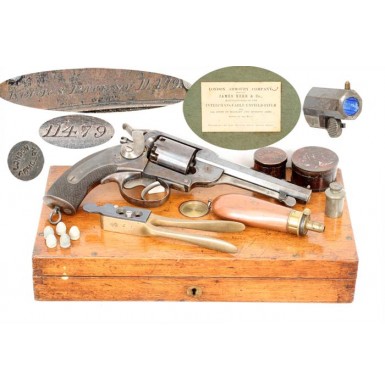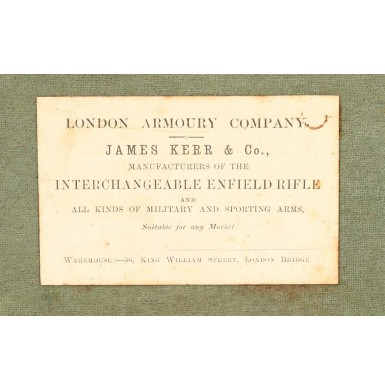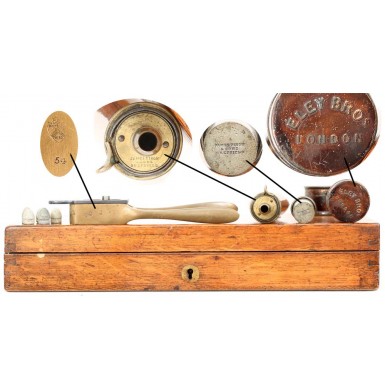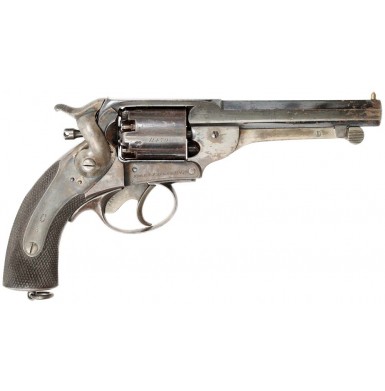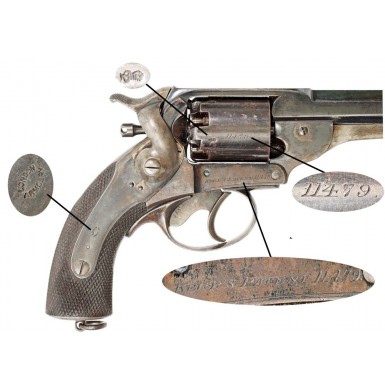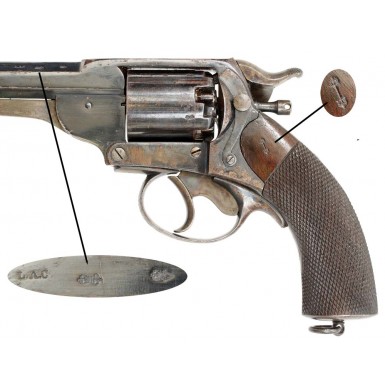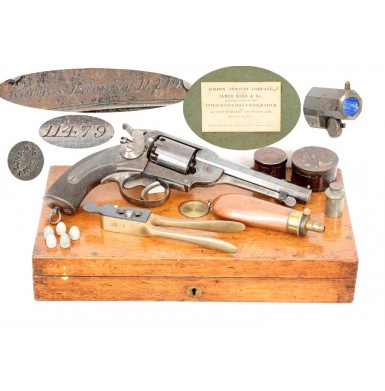The London Armoury Company Kerr’s Patent Revolver is one of the most distinctive and recognizable of all Civil War era handguns. The side mounted hammer & removable side plate were not common features in large bore handguns of the era and result is a unique silhouette. The Kerr patent revolver was invented by James Kerr, who was awarded two patents for improvements to Roberts Adams earlier revolver design. Kerr had been a founding member of the London Armoury Company, which was established on February 9, 1856 and of which Adams was the Managing Director during the late 1850s. It is interesting to note that Kerr was Adams’ cousin and had previously worked with him at Deane, Adams & Deane. Initially the London Armoury Company (LAC) focused on producing M-1854 Beaumont-Adams patent revolvers with an eye towards obtaining lucrative English military contracts. When significant orders were not forthcoming, the company shifted its focus to manufacturing the British Pattern 1853 “Enfield” rifle muskets for both the English government and private sale. This caused a rift within the company management that culminated with the departure of Adams from L.A.C. and the elevation of Kerr to the position of factory superintendent. With the departure of Adams, and the perceived need to offer some form of revolver for sale, the company purchased Kerr’s patent rights and started to produce the Kerr patent revolver in 1859. The first pistol was completed in March of 1859 and was tested at the Royal Small Arms Factory at Enfield Lock on April 25, 1859. The pistol was typical of large bore English handguns of the era, in that it the standard offering was 54-Bore (about .442 caliber), and had a 5-shot cylinder. The gun was manufactured with barrel lengths that varied slightly, with the earliest guns having barrels around 5 ““ in length and the later pistols having slightly shorter barrels that varied between about 5 ““ and 5 5/8”. While the large majority of the pistols produced were in 54-Bore, a small number of very early and very late production pistols were manufactured in 80-Bore (approximately .387 caliber). The majority of the pistols used a single action mechanism, not a double action mechanism as the trigger position makes many people believe. The hammer could only be cocked by pulling it back manually, but pulling the trigger could rotate the cylinder. This was a byproduct of the cylinder locking system, which relied upon a pivoting arm that was actuated by the trigger. This arm locked the cylinder in place when the gun was fired. This was very different from the standard spring-loaded cylinder stop found in the frames of most American made revolvers. This system also eliminated the need to machine stop slots in the cylinder, as the rear face of cylinder was where the arm locked it into position. Only a handful of Kerr revolvers were manufactured as “self-cocking” (double action) revolvers, and they are very rare today. The Kerr also featured a unique, frame mounted cylinder arbor that was removed from the rear of the pistol (much like on the Colt side hammer, aka “Root” designs), instead of the more common location at the front of the cylinder. This made the pistol easier and safer to manipulate when the cylinder had to be removed from the pistol. The early production Kerr revolvers had a small setscrew on the left side of the frame, forward of the cylinder that prevented the cylinder arbor pin from being withdrawn from the rear of the frame. The later production revolvers had a frame mounted spring on the lefts side, similar in appearance to the M-1851 Adams patent safety, which retained the arbor pin. Early production revolvers had a wide groove in the topstrap, while the later production guns had a flat topstrap without a groove. The early guns also had a loading lever that pivoted on a screw located at the lower front edge of the frame, under the barrel. The later production guns moved this pivot point higher and closer to the cylinder, making it somewhat stronger and allowing more torque to be applied to the lever when loading tight fitting ammunition. Most of these early features are phased out in the upper 2,XXX to middle 3,XXX serial number range, although some of the features appear somewhat randomly through about the middle of revolver production, suggesting that sometimes older parts were used to complete orders when time was of the essence. Although the design was reliable and fairly robust, the London Armoury Company did not find any British military contracts forthcoming for their pistol. Between the introduction of the Kerr in 1859 and the beginning of the American Civil War in 1861, only about 1,000-1,500 of the revolvers were manufactured, and even fewer were sold. Most of these pistols were sold commercially (both in Great Britain and in the US), with about 100 of them purchased by an English Volunteer unit “ the 1st Sussex Artillery Volunteers. With the outbreak of the American Civil War, Caleb Huse (the South’s primary purchasing agent in England) engaged the London Armory Company to produce all of the Kerr’s Patent revolvers that they could for delivery to the Confederacy. It is believed that nearly all of the L.A.C.’s output of Kerr revolvers from April of 1861 through the close of the Civil War were produced on contract for the Confederacy, with about 9,000 pistols produced and shipped to the south during that time. It is also estimated that the London Armoury Company produced about 70,000 Pattern 1853 Enfield Rifle Muskets during the same time frame. The estimate regarding revolver production is based upon the extant examples with Confederate provenance or marks, which tend to exist in the 1,500 to about the 10,500 serial number range (although a handful of legitimate CS inspected Kerr’s do in the 7XX to 1,5XX range). To date, at least three separate Confederate government contracts have been identified for the purchase of Kerr revolvers. Two were army contracts, and one was a 1,000-gun contract for the Confederate Navy. The Naval contract was quite early, as reference to the purchase of Kerr revolvers by CSN Commander James D. Bulloch was made in a diary entry by Confederate purchasing agent Major Edward Anderson dated August 6, 1861. Many of the army contract Kerr revolvers were financed through the Charleston, SC based firm of Fraser, Trenholm & Company and delivered by their subsidiary John Fraser & Company. A minimum of 3,160 Kerr revolvers were delivered directly to Confederate arsenals by Fraser. In addition to the 3 government contracts, an unknown number of Kerr’s Patent revolvers were acquired speculatively for sale privately and to the Confederate military once they reached the south. This may account for the number of Kerr revolvers that exist today with unquestionable Confederate provenance, but without the JS/(ANCHOR) Confederate inspection mark. One of the standard indicators of CS importation and usage of a Kerr revolver is the presence of the JS / (ANCHOR) inspection mark that is found on the front of the wooden grip of the pistols, below the grip frame tang. This is the inspection mark of John Southgate, who acted as a “viewer” (arms inspector) for the Confederacy. However, the absence of this mark is not necessarily an indication that the pistol was not a CS purchase. As the information above outlines that the majority of Kerr’s over serial number 1,500 and below 10,500 were produced on contract for the Confederacy. To date, the lowest numbered Kerr to bear the JS/(Anchor) inspection mark that I am aware of is in the lower third of the 7XX range, and the highest verifiable mark is just under 10,000. Over the years, a number of Kerr’s with spurious JS/(ANCHOR) marks have been noted, often found on guns that did not have them when they were first documented during the past 20-30 years, but have had them “magically” appear over the course of time. The best concrete documentary evidence of how high the CS used serial numbers of Kerr revolvers ranged is the Squad Roll of Lt. Julian Pratt of Company H of the 18th Virginia Cavalry. This document lists the pistols in possession of his squad of cavalry in July of 1864. On the list are seven Kerr revolvers that range between #9240 and #9974. Since the Confederacy would continue to import Kerr pistols throughout the end of the war (the last documented shipment was 8 cases in March of 1865), it is not unreasonable to extrapolate CS purchases into about the 10,500 serial number range. It is interesting to note that two of the Kerr revolvers on the Pratt Roll are known to survive today, and revolver #9974 does not have a JS/Anchor mark. While very scarce today, a number of Kerr revolvers were imported with a complete set of accouterments and accessories that would have been included in a cased set. According to Payne Ledger, some 900 Kerr revolvers arrived at the port of Wilmington, NC on October 31, 1864 (more than 3 months after Lt. Pratt’s guns were logged in his roll). These guns also had the following accessories: “Spare Nipples & Cloth Bags, 900 Powder Flasks, 900 Cleaning Rods, 450 Steel Nipple Keys, 180 Bullet Moulds, 180 Mainsprings, 180 Trigger Springs, 90,000 Skin Cartridges, 108,000 Percussion Caps”. The guns were delivered by the blockade-runner Hope, and were part of the consignment purchased through John Fraser & Company. Five hundred of the guns and their associated accouterments were subsequently delivered the Selma Arsenal, and the other four hundred and their accessories were delivered to the Richmond Arsenal. The presence of accessories like cleaning rods, powder flasks, cloth bags and the combination gun tools (“steel nipple keys”), suggest that the guns were purchased as cased sets, and were subsequently repacked into the standard 20 guns per box lead lined cases that most Kerr revolvers were delivered to the Confederacy in. The powder flasks and cloth bags were certainly of limited utility for guns that were designed to be used with pre-made paper or skin cartridges. Bullet molds were typically delivered to the Confederacy at a ratio of 1 for every 20 long arms, but in this case they were delivered at the ratio of 1 for every 5 pistols. The cleaning rods would certainly have been useful in the field, but this is the only report I can find of cleaning rods being purchased by the Confederacy for use with revolvers. All of this suggests that these accessories originated in cased Kerr revolver sets. It seems quite likely that additional cased sets were acquired on a speculative basis for delivery to the south as well. Today all of these accessories are extremely rare, most especially the special Kerr revolver combination gun tool & cone (nipple) wrench. With the conclusion of the American Civil War, the London Armoury Company quickly succumbed to the loss of its largest, and only, major customer. The company closed exactly one year after the end of the American Civil War, in April of 1866, and it believed that the remaining factory assets and machinery were sold to a gun making company in Spain the following year. The Spanish had been producing an unlicensed copy of the Kerr since 1862, primarily assembling the guns from Belgian made parts. This had proved a somewhat unreliable system of production and made it difficult to obtain parts for repairs. By obtaining the actual machinery, it was possible to keep Kerr patent revolvers in Spanish service through the Spanish American War period (primarily as cartridge altered guns). James Kerr himself did remain in business for some time after this, and assembled and sold Kerr revolvers from the existing stock of parts. This accounts for the post 11,000 serial numbered pistols occasionally encountered “ occasionally in relatively nice condition. On a side note, collectors and researchers have long debated the correct pronunciation for James Kerr’s last name. According to Val Forgett Jr. -gun collector, researcher and current owner of Navy Arms, his extensive research indicates that even the British disagree about the pronunciation, but the most correct pronunciation would almost certainly be KARR, while the next most common pronunciation would be KARE. The Americanized pronunciation is CUR.
The Kerr’s Patent Revolver offered here is an extremely scarce, fully cased example in NEAR EXCELLENT condition. The gun was retailed by James Kerr after the dissolution of the London Armoury Company, but appears to have been assembled from parts manufactured prior to the London Armoury Company’s failure. The revolver retains a full complement of period and original accessories. The gun is serial numbered 11479 on the right side of the frame and on the cylinder. The lock plate of the pistol is clearly marked in a small, two-line, stamped, oval cartouche: LONDON / ARMORY. The lock marking is not the large, engraved London Armoury mark typical of pre-civil War and Civil War era Kerr revolvers, suggesting it was produced after the failure of the company, but that Kerr was still trying to trade on the company name as a sign of quality. The mark was made with the same stamp that was used to mark the left side of the frame of earlier production Kerr revolvers. The right side of the frame is marked: KERR’s PATENT 11479 and the matching serial number 11479 appears on the cylinder as well. Alternating (Crown) / V and (Crown) / GP marks are also found between the chambers of the cylinder. The left upper flat of the octagonal barrel is marked near the frame: L.A.C. along with the commercial London view and proof marks of a (Crown) / GP and (Crown) / V. The pistol is marked with the typical London Armoury Company assembly numbers. The number is present on the face of the cylinder, inside the trigger guard, on the trigger web and inside the bottom of the frame. The assembly number is 227 and matches in all of these locations. These assembly numbers are often illegible due to wear at the face of the cylinder and inside the frame, and only the number in the triggerguard typically survives clearly readable. The original cylinder pin retention spring is present and secure, and the action of the pistol works perfectly. The timing and lock up are very good as well. The original loading lever is present and functions smoothly also. The gun retains about 80%+ of its original blued finish overall. The barrel retains about 85% of its original bright, rust blue but shows some minor wear and finish loss, mostly along the sharp edges and points of contact, combined with some flaking around the muzzle. The frame retains about 70%+ of its original blued finish with most of the loss being due to flaking along the lower portion of the frame on both sides. The barrel web forward of the cylinder and the top strap both retain nearly all of their original bright blue. The areas of the frame where the finish has flaked have a nice, smooth, plum brown patina, with flecks of blue remaining. The cylinder retains about 85% of its original blue as well. The hammer also retains about 80%+ of its original case coloring, which has dulled and faded somewhat, and has a smoky gray undertone. There is some minor finish loss along the sharp edges and contact points of the hammer. There is also moderate loss of blue along the contact points of the backstrap, frontstrap and triggerguard. As with the lower frame, the areas where the blue has worn or flaked now have a smooth plum brown patina that blends well with the remaining finish. The lock plate retains about 80%+ of its original mottled case coloring, with the expected fading and dulling from age, making the colors somewhat less vivid than they were when new. The loading lever retains a similar amount of case coloring, and also shows some minor dulling and fading. The case hardened trigger retains about 65%+ case coloring, with the same muting, fading and dulling noted on the lock plate and loading lever. The fire blued spring cylinder arbor pin retaining clip and the loading lever locking clip both retain about 80%+ brilliant purplish-blue finish and are quite attractive. All of the edges and markings of the pistol remain extremely sharp and crisp. Like most Kerr revolvers, this one has a lanyard ring in the butt caps. The butt cap, retain about 40%+ of its original finish, which had blended with a smooth plum-brown patina. The original brass post sight is present on the end of the barrel near the muzzle and remains full height with the original crowning to its end. The bore of the pistol is in about EXCELLENT condition and remains quite bright and sharp. The bore retains very crisp rifling, and shows only the most minor traces of lightly scattered pinpricking in the grooves. The one-piece checkered walnut grip is in about EXCELLENT condition as well. It retains extremely sharp checkering over most of its surface, with only the most minor indication of handling and light use. The grip is free of breaks, cracks, chips or repairs, and have a rich chocolate brown color.
The pistol is contained within its original English casing and is complete with all a full complement of original and period accessories. The casing is typical varnished English oak design with brass hinges and a brass escutcheoned lock on the front. The case is in about VERY GOOD condition and shows moderate wear and finish loss, along with a couple of more recent dings and mars. The case shows some small chips and dings, and a couple of very minor surface grain cracks. The brass lock escutcheon is in place in the front of the case, but the key is missing. The interior compartments are lined with a faded green baize that shows good age and wear, and appears to be completely original to the casing. The case is in solid condition with no serious weakness to the structure itself or the interior compartment dividers. The brass hinges may be period replacements, or may simply be worn, as the “bible” hinges no longer hold the lid upright when open, allowing it to fold over completely to the rear. There is a wonderful original James Kerr retailer label inside the case lid. The label reads in eight lines:
LONDON ARMORY COMPANY / JAMES KERR & Co., / MANUFACTURERS OF THE / INTERCHANGEABLE ENFIELD RIFLE / AND / ALL KINDS OF MILITARY AND SPORTING ARMS, / Suitable for any Market. / WAREHOUSE: - 36 KING WILLIAM STREET, LONDON BRIDGE.
The paper label remains in FINE condition with some age staining and light foxing present, mostly around the edges. The label seems to be straddling a fine line between trading upon the name of the defunct London Armoury Company, while still making it apparent that the retailer is actually James Kerr & Co, the struggling successor to L.A.C. Realistically, based upon the serial number of the gun and the label in the case the revolver was probably produced and retailed in late 1866 or early 1867, and is likely among the very last of the Kerr revolvers produced in England, prior to the sale of the remaining parts and machinery to produce the guns to Spain. The case is filled with the expected Kerr revolver accessories, all of which are contained in compartments. Included in the casing are the following original related Kerr accouterments:
1) 54-Bore Bullet Mould, in EXCELLENT condition. The mold is the typical 2-cavity brass mold found in many English casings, but casts two Kerr’s patent pointed-round nosed bullets with a single grease groove and shallow heel. The mold is marked 54 on the side, indicating 54-Bore. The mold is also marked with a Robert Adams patent mark, suggesting the mold may have been obtained from the former London Armoury employee who was running his own business at the time. Adams marked molds are typically encountered in late production cased Kerr revolver sets, suggesting that Kerr was obtaining his molds from Adams rather than making them himself. The mold cavities are distinctly Kerr in style and not the half-circle round-nose shape of Adams patent bullets. The brass body has a rich ocher patina that is untouched and uncleaned, and the mold cavities remain bright and clean with excellent edges. The blued sprue cutter is in wonderful condition, functions smoothly and retains about 70% of its original bright fire blue, which is fading and starting to turn a plum-brown color.
2) Powder Flask in about FINE overall condition. The small bag shaped flask is of copper with an adjustable brass spout and top. The body of the flask retains much of its original protective varnish and shows only a few small bumps and dings. The polished brass top is clearly marked in three lines JAMES . DIXON / & SONS / SHEFFIELD. The original fire blued closure spring is in place on the top of the flask and the flask functions correctly. The adjustable spout allows the flask to throw charges of 3/8, 1/2 or 5/8 Drams of powder.
3) Cap Tin in FINE condition. This original jappaned tin is empty, but retains much of its original finish. The lid is clearly embossed with ELEY BROs in an arc over LONDON.
4) Pewter Oiler in EXCELLENT condition. The oiler is complete with the detail oiler attached to the inside of the lid. The bottom of the oiler is clearly marked: JAMES DIXON / & SONS / SHEFFIELD.
5) Jappaned Tin for Bullets in FINE condition. The jappaned tin shows bumps, dings and dents from handling and use and from holding the lead bullets. It retains most of its original paper lining. It is unmarked and empty.
6) 5 Lead Bullets in VERY GOOD condition. The bullets have a thick white age patina. The bullets have a more rounded ogive than the mold cavities and appear to be more typical of Adams bullets than Kerr bullets. They do, however, add nicely to the display of the set.
Overall this is a really wonderful example of a very late production Kerr’s Patent Revolver complete with original casing and accessories. The pistol is about EXCELLENT condition and is surely an investment-grade example that would be rather difficult to upgrade from. The gun is absolutely 100% complete and correct in every way and is in perfect mechanical condition. This will be a wonderful addition to your collection of English percussion revolvers and is a perfect bookend to show the last of the English made percussion Kerr revolvers, which were soon supplanted Spanish made percussion and later cartridge Kerrs.
Provenance: former Sydney Kerksis collection SOLD

